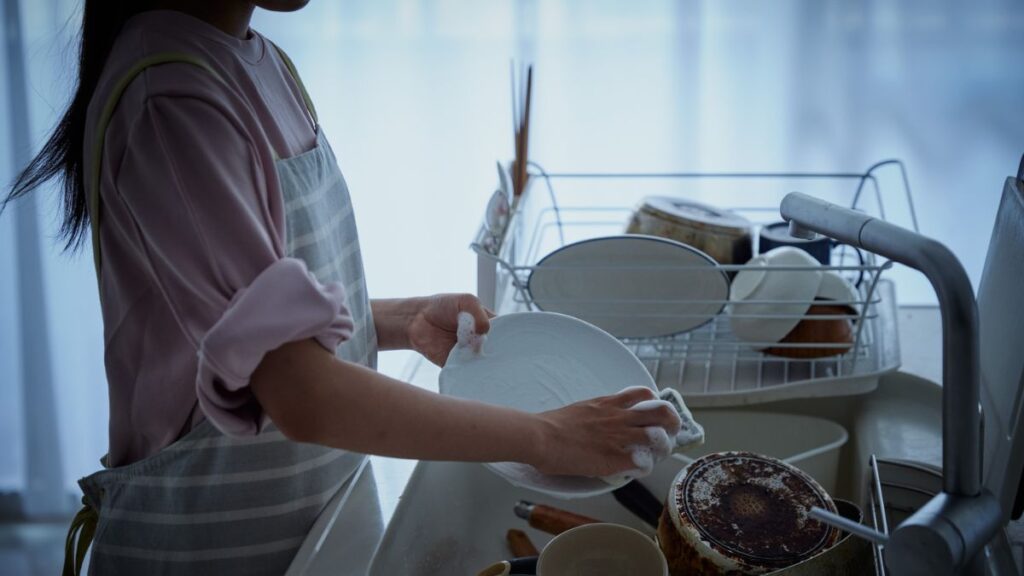
You step up to the sink and glance around — no single-use bottles, no colorful sponges wrapped in plastic. A plastic free dishwashing routine sounds unfamiliar at first, but it’s surprisingly easy and satisfying to adopt.

Reusable Cleaning Cloths
Clean greener and smarter! Discover the best eco fabrics, care tips, and simple wins for reusable cleaning cloths.
Switching to plastic free dishwashing routines has a ripple effect far beyond your kitchen. The shift means fewer microplastics down the drain, fewer harsh chemicals, and a cleaner planet. Every plate you scrub this way inches your home cleaning habits forward.
If you’ve ever wondered whether your small habit changes still matter, this micro-guide will prove they do. Dive into these creative yet realistic steps to start a plastic free dishwashing routine that fits any home and lifestyle.
Switch Gear: Replacing Plastics with Functional Alternatives
An immediate impact comes when you swap out common plastic dish tools for durable, planet-friendly alternatives that last longer and look great on your countertop.
Reducing plastic waste starts with each dishwashing tool you touch. Bamboo brushes, coconut fiber scourers, and reusable cloths each serve a clear purpose — and they clean just as well as their plastic counterparts.
Upgrade to Wooden and Natural Brushes
Choosing wooden handles and plant-based bristles for a plastic free dishwashing toolkit means your cleaning gear won’t shed microplastic fibers during use. These brushes, especially with replaceable heads, make routine swaps effortless.
Bamboo dish brushes with hard bristles cut through baked-on food the way a plastic scrubber would, but leave only biodegradable traces behind. Store the brush upright to ensure it dries quickly, prolonging its life and preventing mildew.
A little upkeep goes far: once a week, soak your wooden brush in vinegar-water, then rinse and let dry. This routine keeps it clean, naturally sanitized, and odor-free, supporting a truly plastic free dishwashing experience.
Choose Cellulose Sponges or Loofah Pads
Natural cellulose sponges and loofah pads don’t release synthetic particles. Run a loofah over a greasy pot, rinse it well, and hang it up to dry for repeated use.
If you like a traditional sponge’s feel, opt for those labeled 100% plant-based; squeeze excess water after every use and set it in a dry spot. These options rival plastic sponges in performance without lingering waste.
When your natural sponge wears out, toss it into a home compost pile rather than the trash. This simple action closes the loop, keeping your plastic free dishwashing routine sustainable and low-waste.
| Tool | Main Material | Longevity | What to Try Next |
|---|---|---|---|
| Bamboo Dish Brush | Bamboo/Wood + Plant Bristles | 3-6 months | Replace heads, compost bristles & handle |
| Cellulose Sponge | Plant fibers | 2-3 weeks | Frequent boiling, compost when worn |
| Loofah Pad | Dried gourd fiber | 4-8 weeks | Hang dry, compost when finished |
| Coconut Fiber Scourer | Coconut husk | 2-3 months | Rinse thoroughly, compost after use |
| Reusable Cloth | Cotton/Linen/Hemp | Up to 1 year | Wash weekly, upcycle or compost at end of life |
Soap Smart: Selecting Truly Plastic Free Dishwashing Cleaners
When you make the switch, your cleaning products shouldn’t leave behind empty bottles. Bar soaps and refill stations ensure every wash stays plastic free, helping eliminate packaging completely from your dishwashing process.
Even if liquid soap is your old standby, look for local dish soap refilleries that let you reuse the same container endless times. A hard dish soap block on a ceramic dish is another hassle-free solution.
Look for Plant-Based Ingredients and Minimal Packaging
Check for soap bars wrapped in paper or bulk solid soap sold without packaging. Ask for ingredients like coconut oil, olive oil, or essential oils rather than synthetics that don’t break down naturally.
- Switch to solid dishwashing soap blocks: eliminate bottles and pump tops from daily use, and one block lasts weeks before needing to be replaced. To use, rub a damp brush directly onto the block and scrub.
- Use powder dish soap from paper packets: pour into a jar at home, and measure out with a reusable scoop. The powder dissolves easily and does the job with zero plastic footprints.
- Find refill stations for liquid dish soap: bring your own container, get a measured refill, and keep your plastic use in check with every visit. Mark your bottle’s fill date at home for quick inventory.
- Choose dish soap in compostable tins: opt for solid soap shaped to fit palm-sized tins, then toss the container into your compost or recycling bin when it’s empty.
- Seek out entirely plastic free dishwashing soap brands: verify there are no plastic seals, pumps, or internal packaging before buying, and share these finds with friends to spread the habit.
Shifting to a plastic free dishwashing soap simplifies your under-sink arrangement and can save money in the long run. There’s no need to shop every few weeks, nor stockpile single-use containers.
Deciphering Dish Soap Labels: What to Watch For
Scan for certifications signaling biodegradable ingredients, no animal testing, and non-toxic formulas. Make sure claims like “eco-friendly” match your plastic free dishwashing standards by checking packaging details and brand transparency.
- Prioritize clear labeling: seek soap bars that list all materials—plant oils, lye, and mineral powders—so you know what’s going down the drain and back into the environment.
- Avoid anything with microbeads, SLS, or undisclosed “fragrance”: these are red flags for plastic derived or polluting ingredients, even if the packaging looks green.
- Choose products with visible certifications: look for clear seals from reputable organizations showing the soap’s compostability, vegan contents, or fair-trade status.
- Opt for unbleached or natural colored paper: this means fewer chemicals and streamlined recycling or composting at home.
- Contact makers or retailers directly: ask “Is this product fully plastic free, including the label wrap and shipping?” to get clear, actionable answers before you spend money.
By making deliberate decisions on cleaning agents, you strengthen each step of your plastic free dishwashing routine, empowering every family member to do the same.
Rinse and Repeat: Managing Water Use and Drying Alternatives
Cutting plastic out of dishwashing naturally raises the bar for mindful water use and drying tools. The less water and energy you waste, the smarter and more sustainable your kitchen routine becomes.
Set up obvious reminders at the sink, like a timer or written note, to keep rinsing times brief and intentional. This reinforces low-waste habits for everyone at home—no guessing, just swift, practical steps that add up fast.
Short, Targeted Rinses Conserve Water
Pre-scrape plates with a rubber spatula or natural brush into the compost jar, then rinse with a minimal stream. Consider “scrape, soap, swipe, and rinse” as your dishwashing rhythm for plastic free living.
Instead of continuous running water, fill one basin or bowl with soapy water for washing, and a second with clean water for rinsing. This intentional setup slashes water use compared to letting the faucet run throughout.
Practicing this sequence teaches kids and housemates firsthand how to build a conscious plastic free dishwashing routine—hands-on actions work better than reminders alone.
Drying Dishes Without Plastic-Based Cloths
After washing, go for cotton or linen dish towels instead of microfiber, which releases plastic filaments with every wash. Hang towels on a rack immediately after use to prevent mold or odors.
Rotate several towels, swapping in a fresh one every day. Let the heavily used ones air out completely before tossing them in with your next laundry load and composting at the end of their life span.
A simple wooden rack or a hanging rail above your countertop offers a dedicated, plastic free drying zone and signals where clean, dry towels always belong. Everyone adapts quickly with visible tools in place.
Divide and Conquer: Dish Sorting for Efficient Washing
Sorting dishes before washing makes the process easier, and limits the amount of water, soap, and scrubbing you need—streamlining your plastic free dishwashing routine every single day.
Group similar items together on the counter or in a dry basin: the most soiled cookware, medium-dirty plates, and lightly used glasses or cutlery all get dealt with in logical order.
Pre-Soaking Strategy: Acting Before It Dries
Fill a large bowl or your sink with hot water and a dab of your plastic free dishwashing soap, letting cookware with baked-on messes soften before you scrub. This short soak saves elbow grease and cleans more thoroughly.
Pretend you’re a chef after a busy dinner party: fill a deep bowl, drop in pans, and pile plates beside for a few minutes. This routine lets you tackle the hardest jobs first, with little extra effort.
Tell others in your home: “Just drop grimy pans in the soak bowl—leave all else beside it.” This habit catches messes early and encourages everyone to minimize soap and water waste.
Quick Rinsing Technique: Staying Ahead of Stuck Food
Flash rinse dishes right after meals, even if you’re not washing them immediately. A short shower of water, a quick swipe with a plastic free dishwashing brush, and plates will never dry out with residue.
While prepping a meal, grab your cloth and wipe down tools as you go. Slicing boards and mixing spoons get cleaned and set aside, ready for re-use later or a proper wash without clinging buildup.
Make it a friendly kitchen rule: “Rinse first, wash when you have a full batch.” This keeps washing manageable for everyone—no caked-on frustrations, no wasted resources.
Optimize Storage: Keeping Your Tools Clean and Ready
Maintaining plastic free dishwashing tools means storing each item with care—dry, separated, and visible, so nothing wears out faster than necessary or accumulates mold. This method extends usefulness and prevents unnecessary replacements.
Hung brushes, neatly folded towels, and sun-dried loofahs all boost hygiene and help family or housemates know what’s clean and ready to use, reinforcing the plastic free dishwashing system daily.
Organize Storage Zones for Each Tool
Assign a hook or simple jar for every brush and sponge, so wet items never sit in puddles. You don’t need complicated organizers—an old mug for upright brushes and a shallow bowl for soap is enough.
Designate a specific shelf or basket for rolled towels, with a clear label or visual cue if needed. This keeps cloths rotating and signals when to launder another batch—no more mystery odors or sour surprises.
Analogous to a tidy garden shed, visible organization prompts use and care. Encourage everyone to return things to their spot—just as gardeners hang up their trowels at the end of a day’s work.
Rotate, Refresh, and Compost When Needed
Make a calendar note every 2–3 weeks for sponge or brush replacement. Drop old tools into your compost and introduce a fresh one at the same time for zero-plastic waste.
Check for cracked handles, worn bristles, or sour-smelling towels whenever you tidy the kitchen. This visual check makes sure only effective, hygienic tools are in action—your plastic free dishwashing stays efficient year-round.
Encourage kids or housemates by making a “replacement day” ritual. Gather used up sponges and brushes, add them to the compost pile, and distribute fresh tools so everyone feels invested in the system.
Sharing and Teaching: Building Household Buy-In
Plastic free dishwashing works best when everyone understands why you’ve made these changes and how to take part. Visible instructions and simple demonstrations inspire collaboration, rather than confusion or resistance.
Explicitly point out where to find natural brushes, which towels to use, and how to refill soap. Modeling the behaviors yourself solidifies the new routine—others quickly catch on when the system is clear and accessible.
Make the Routine Visible and Inviting
Leave out examples: a wooden brush and soap block sit by the sink, a drying towel hangs neatly above, and compostable sponges rest on a tray. These signals cue everyone to use—and return—plastic free dishwashing supplies.
Say “Try this soap bar next time,” or, “Let’s stash all the brushes on this rail,” and keep instructions friendly and interactive, aiming for gentle reminders until the routine sticks for everyone.
When houseguests help out, provide a quick, upbeat walkthrough: “Here’s our brush, here’s the solid soap—no plastic bottles in this house!” This hands-on guidance brings others into the plastic free dishwashing mindset, even just for a visit.
Household Checklists and Visual Aids
Make laminated cards or hand-drawn checklists to leave near the sink, listing every step of your plastic free dishwashing routine. Include reminders like “rotate towels daily,” or “refill soap from the jar.”
Kids love stickers or colored markers to track replacement days or cleaning schedules. This participatory approach builds ownership, responsibility, and pride in maintaining the plastic free dishwashing system as a family or community.
Update checklists every month to include seasonal tasks—like deep cleaning tools, checking the compost, or swapping storage baskets. This adaptability keeps the system relevant and visible for everyone involved, supporting the longevity of your efforts.
Moving Forward: Reinforcing Your Plastic Free Dishwashing Habits
Regularly checking in with your current practice helps reinforce what works and exposes weak spots, keeping your plastic free dishwashing commitment meaningful and flexible for your household.
Small tweaks are always possible—whether that means rotating in a new soap brand, replacing tools more often, or coming up with creative incentives to keep family members engaged.
Your consistency builds lasting impact. Friends, neighbors, and kids all notice when single-use plastics disappear from the kitchen and an easy, sustainable system visibly takes their place.
An organized cabinet, compostable tools, and a visible soap block each reinforce your values every day—not by accident, but by design. Feel the satisfaction from every load of clean, plastic free dishes.
This ongoing approach makes your home a model for low-waste cleaning. As each plastic free dishwashing cycle repeats, imagine others adopting similar systems simply by seeing your routine in action.
Frequently Asked Questions
Boil the sponge in water for five minutes or soak it in a vinegar-water solution. Let it air dry completely before using it again, and compost when it breaks down or gets too thin for scrubbing tasks.
Yes, plastic free dishwashing bars are highly concentrated and tackle tough grease easily. Rub your damp brush or a loofah directly on the bar until you create enough lather, then scrub cookware as needed and rinse with hot water.
Use clear, friendly instructions and show them where every tool belongs. Offer regular praise for their efforts and set simple visual checklists by the sink so they can follow the steps and replace items when needed.
Yes. Use the “wash in one basin, rinse in another” method and keep rinsing brief. Pre-scrape plates and avoid running water continuously. This approach naturally limits waste while supporting your zero-plastic commitment.
Hang wooden brushes with the bristles pointing downward or place them handle-down in a cup to allow airflow. This prevents mildew, extends life, and keeps your plastic free dishwashing system hygienic and ready for daily use.

DIY Carpet Freshener with Essential Oils
Refresh your floors naturally! Make a DIY carpet freshener with essential oils for a clean, long-lasting scent at home.


